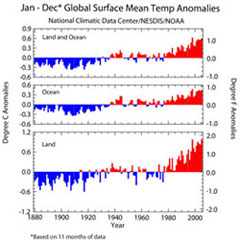NOAA report reconciles atmsopheric temperature discrepancy
NOAA
May 3, 2006
The U.S. Climate Change Science Program issued the first of 21 Synthesis and Assessment S&A Products today with findings that improve the understanding of climate change and human influences on temperature trends.
“Temperature Trends in the Lower Atmosphere: Steps for Understanding and Reconciling Differences,” also referred to as S&A Product 1.1, tackles some of the long-standing difficulties that have impeded understanding of changes in atmospheric temperatures and the basic causes of these changes.
According to the published report, there is no longer a discrepancy in the rate of global average temperature increase for the surface compared with higher levels in the atmosphere. This discrepancy had previously been used to challenge the validity of climate models used to detect and attribute the causes of observed climate change. This is an important revision to and update of the conclusions of earlier reports from the U.S. National Research Council and the Intergovernmental Panel on Climate Change.
“This synthesis and assessment report exposes the remaining differences among different observing systems and data sets related to recent changes in tropospheric and stratospheric temperature,” said Chief Editor Thomas Karl, director of the NOAA National Climatic Data Center. “Discrepancies between the data sets and the models have been reduced and our understanding of observed climate changes and their causes have increased. The evidence continues to support a substantial human impact on global temperature increases. This should constitute a valuable source of information to policymakers.”
 Image courtesy of NOAA. RELATED ARTICLES Greenhouse gases hit record in 2005: Atmospheric levels of gases believed to be fueling global warming continued to climb in 2005 according to analysis released by the U.S. National Oceanic and Atmospheric Administration. The agency said its index of greenhouse gases — the Annual Greenhouse Gas Index or AGGI — showed an increase in carbon dioxide (CO2) and nitrous oxide but a leveling off of methane, and a decline in two chlorofluorocarbons (CFCs), gases that contribute to the hole in the ozone layer above Antarctica. NOAA reports that overall, the AGGI “shows a continuing, steady rise in the amount of heat-trapping gases in the atmosphere.” |
|
S&A Product 1.1 corrects errors that have been identified in the satellite data and other temperature observations. These and other analyses have increased confidence in the understanding of observed climatic changes and their causes. The published report also states that research to detect climate change and attribute its causes using patterns of observed temperature change in space and time shows clear evidence of human influences on the climate system due to changes in greenhouse gases, aerosols and stratospheric ozone. Also, the observed patterns of change over the past 50 years cannot be explained by natural processes alone, nor by the effects of short-lived atmospheric constituents such as aerosols and tropospheric ozone alone.
The previously reported discrepancy between surface and atmospheric temperature trends is no longer apparent on a global scale. These trends are consistent with climate model simulations. One issue does remain, however, and that is related to the rates of warming in the tropics. Here, models and theory predict an amplification of surface warming higher in the atmosphere. However, this greater warming aloft is not evident in three of the five observational data sets used in the report. Whether this is a result of uncertainties in the observed data, flaws in climate models, or a combination of these is not yet known. Using the evidence available, the author team favors the first explanation.
“The publication of S&A Product 1.1 signals a tremendous accomplishment, not simply because of its scientific content, but also because of the breadth in scope of contributing authors’ backgrounds and the meticulous research they undertook,” said James Mahoney, recently retired CCSP director. “The findings reflect years of effort in tackling difficult and complex issues that have hampered our understanding of global climate. It is the first of several significant products that are illustrative of the outstanding research that will result from the CCSP.”
During a workshop in 2002 that was attended by senior leadership in the administration’s scientific agencies, as well as more than 1,000 physical and social scientists, the CCSP adopted five overarching scientific goals that guide all climate research conducted by the federal government. The 21 S&A Products further refine these goals and address key topics that are necessary to resolve in order to make well informed decisions. The S&A Products are designed to inform public debate, policy and operational decisions, as well as defining and setting the future direction and priorities of the program.
NOAA, an agency of the U.S. Department of Commerce, is dedicated to enhancing economic security and national safety through the prediction and research of weather and climate-related events and providing environmental stewardship of the nation’s coastal and marine resources.
Through the emerging Global Earth Observation System of Systems (GEOSS), NOAA is working with its federal partners, 61 countries and the European Commission to develop a global network that is as integrated as the planet it observes, predicts and protects.
The body of this article is a modified news release from NOAA.